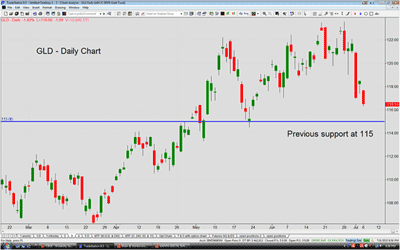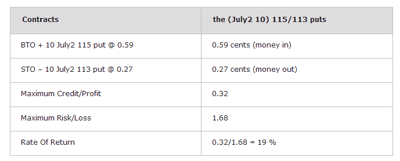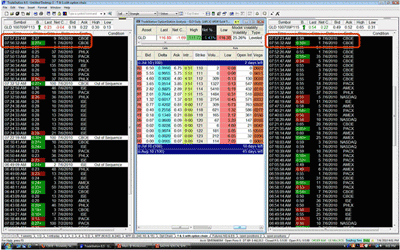In this article, I will share with the readers some great news: The weeklies have finally arrived on the SPDR Gold Trust ETF (GLD). By the time this article gets published, the trade that I have placed will be completed. I am going to walk the readers through my thinking process for placing a bull put (short vertical) spread on GLD using the newly listed weekly options.
I have written several articles about the weeklies on the major exchange traded funds since their inception on June 4, 2010. The weeklies have been around on the major indices for a while, but not on the ETFs. See also one of my previous articles, Should You Be Trading Weekly Options?
As always, I urge the novice option traders to start with paper trading spreads at first. Normally, we would let the current implied volatility (IV) determine the appropriate option spread strategy. However, since these are very short-term options with only a one-week maximum time frame, we will keep it simple and use a vertical credit spread. One thing to keep in mind is if the IV was too low, the premium would not be "juicy" enough to sell, but since the premium was worth selling this time, it can be implied that the IV was high enough.
Selection of an option strategy based on the current IV has nothing to do with selection of market direction. It is chart analysis that determines the market outlook, either bearish or bullish. Once again, technical analysis (TA) is when to get in or get out. In other words, TA is about the timing of the trade. The fundamental analysis (FA) is what instrument to trade. Without sounding arrogant, I will say that I do not foresee GLD getting delisted as Fannie Mae and Freddie Mac were. This leads to the conclusion that fundamentally, GLD is a wise selection.
Going back to TA, let me make an observation that just because the correct trading instrument was selected, it does not mean that the trade will turn out to be a winner. If the forecasted direction was wrong, then the perfect selection of a strategy, as well as the instrument, does not matter. Let us examine the chart below.
Figure 1
The figure above shows the daily chart of GLD, with the blue horizontal line marking previous support at 115 where GLD has bounced before. Keeping in mind that the trade I am planning to sit in would last only a few days, I have made the following assumption: GLD had weekly options listed on them that were tradable only until Friday, July 9, 2010, and I had to be correct on my technical forecasting only for the duration of a short week. On Monday, July 5, 2010, the market was closed due to the July 4 holiday.
My postulation was that I am willing to own gold (GLD) at 115 and not at its current price of 116.80. Moreover, I would like to get paid for my willingness to own it at 115. A big chunk of my capital will be placed in the margin/maintenance by my broker when I sell a number of contracts of the weekly July 2 115 cash-secured put. Selling an option gives me an obligation to buy the stock. My premium is limited to the amount of premium that I take in, and at the same time, my exposure to downside risk is unlimited.
At the same time, I would like to buy some protection just in case GLD goes below the 113 level. By simultaneously selling the 115 put and buying the 113 put, I no longer have a cash-secured put type of scenario. Now I have a short vertical, or a bull put spread.
Figure 2
The chart above is self-explanatory and it shows a 19% rate of return for the investment that lasted from Tuesday until Friday. All that is expected from the trade is that GLD stays above 115, and the technical analysis supports that argument. However, the 19% or 0.32 cents per share is the maximum profit. Right after I get filled on my orders, I place an OCO (one cancels other) order that covers me for either a winning trade or a stop to get out if the market direction proves me wrong. The winning exit is a GTC (good 'til cancelled) order to buy back my short (obligation) 115 put for a nickel. Buying back my obligation lifts my margin/maintenance of 1.68 per share, which I could then utilize in some other trades. I place the other order to buy back the vertical for a small loss contingent on GLD going a few cents below the 115 support level.
Figure 3
Figure 3 shows the time and sales of two options contract mentioned earlier. Noticed that I first entered into my short vertical with a single contract, and then I sent the rest of the nine contracts in at the same price level.
In conclusion, once a basic option strategy is mastered, a similar type of trade could be placed over and over again. There is no need for reinventing the wheel. Make sure that the correct product/instrument is selected for trading, as well as the correct option strategy, based on the current implied volatility. Last but not least, technical analysis must be impeccable. Always have a backup plan in case something goes wrong.
By Josip Causic, instructor, Online Trading Academy























